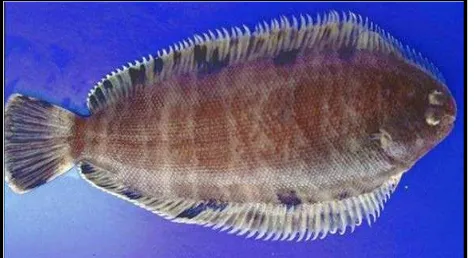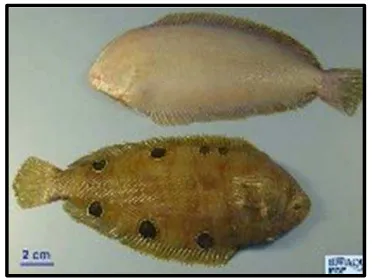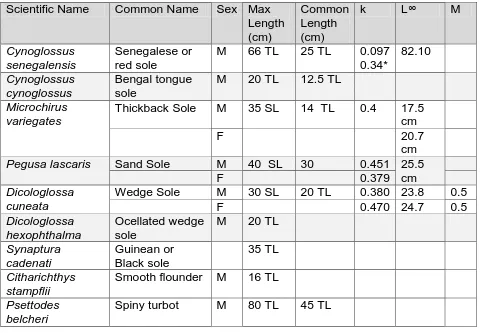Identification of the Sole Resources
of The Gambia
Gambia-Senegal Sustainable Fisheries Program
(Ba Nafaa)
2
This publication is available electronically on the Coastal Resources Center’s website at http://www.crc.uri.edu. For more information contact: Coastal Resources Center,
University of Rhode Island, Narragansett Bay Campus, South Ferry Road,
Narragansett, Rhode Island 02882, USA. Tel: 401) 874-6224; Fax: 401) 789-4670; Email: [email protected]
The BaNafaa project is implemented by the Coastal Resources Center of the University of Rhode Island and the World Wide Fund for Nature-West Africa Marine Ecoregion (WWF-WAMER) in partnership with the Department of Fisheries and the Ministry of Fisheries, Water Resources and National Assembly Matters.
Citation: Coastal Resources Center, 2011. Identification of the Sole Resources of The Gambia. Coastal Resources Center, University of Rhode Island, pp.11
Disclaimer: This report was made possible by the generous support of the American people through the United States Agency for International Development (USAID). The contents are the responsibility of the authors and do not necessarily reflect the views of USAID or the United States Government. Cooperative Agreement # 624-A-00-09-00033-00.
Cover Photo: Coastal Resources Center/URI Fisheries Center
3
The Sole Resources
Proper identification of the species is critical for resource management. There are four major families of flatfish with representative species found in the Gambian nearshore waters: Soleidae, Cynoglossidae, Psettododae and Paralichthyidae. The species below have been confirmed through literature review, and through discussions with local fishermen, processors and the Gambian Department of Fisheries. Many of them are similar in appearance and can be easily misidentified. This short publication is a review of the species and their identifying characteristics.
Soleidae Family (Sole)
Black sole, Synaptura cadenati (also called tiger sole) Thickback sole, Microchirus variegatus
Wedge sole, Dicologlossa cuneata Sand sole, Pegusa lascaris
Oscillated wedge sole, Dicologlossa hexophthalma (palpal)
Cynoglossidae Family (Tongue sole)
Bengal tongue sole, Cynoglossus cynoglossus Red sole, Cynoglossus senegalensis
Psettodidae Family (Turbot)
Spiny turbot, Psettodes belcheri (trippo)
Paralichthyidae (Sand dabs)
4
Soleidae Family (Sole)
The sole fish, Soleidae, (or true sole) are strongly compressed and elongate flatfish with eyes on the right side of the body. Their single lateral line is straight. The dorsal and anal fins are completely separate from, adjacent to or fused with the caudal fin.
Figure 1. True sole, (Line drawing from the FAO Identification Sheet).
Figure 2. Black or tiger sole, Synaptura
cadenati Photo by G. Gabis, close up from
Bellemans et al., (1988).
THE BLACK SOLE.
The black sole is characterized by the small white spots on the body. There is no break between the dorsal, anal and caudal fin.
Detail dorsal, anal and caudal fin
Figure 3. Thickback sole, Microchirus
variegates. Picture From FISHBASE, close
up from Bellemans et al., (1988).
THICKBACK SOLE.
The thickback sole is distinguished by the small pectoral fin (on eyed side (small on blind side). Anterior nostril on eyed side with backward pointing tube reaching to front border of lower eye.
5 Figure 4. The wedge sole, Dicologlossa
cuneata Line drawing From FISHBASE,
closeup from Bellemans et al., 1988)
THE WEDGE SOLE.
The Wedge Sole is brownish grey with small dark spots. The pectoral fins are blackish with a pale margin. The anterior nostril is small.
Detail
Figure 5. The Sand Sole, Pegusa lascaris. Line drawings from Schneider, 1990 and Bellemans et al., 1988
THE SAND SOLE.
The sand sole is brownish yellow or reddish brown with obscure pale
blotches and specks. Last ray of dorsal and anal fins joined by a low membrane to the base of the caudal fin.
Supratemporal lateral line forms an arch. Anterior nostril on blind side prominent forming a large round rosette, its diameter equal to eye.
Detail
Figure 6. Oscillated wedge sole ,
Dicologlossa hexophthalma, (Called Palpal).
OSCILLATED WEDGE SOLE:
6 Picture and drawing from FISHBASE.
Psettodidae Family (Turbot)
The Psettodidae possess large mouths with large teeth. The dorsal fin does not extend forward onto head; eyes can be on either side of the head.
Figure 7. Spiny turbot, Psettodes belcheri (Photo: K. Castro).
THE SPINY TURBOT has
7
Paralichthyidae (Sand dabs)
Paralichthyidae are characterized by: eyes on the left side; presence of pectoral fins on both sides with branched rays..
Figure 8. Smooth Flounder Citarichthys stampfilii (Photo: G. Gabis; Drawing: FISHBASE)
THE SMOOTH FLOUNDER.
8
Cynoglossidae Family (Tongue sole)
Although similar to the sole fish, tongue sole (Cynoglossidae) can be distinguished by the presence of a continuous fin around the body that joins the dorsal, caudal and anal fin, absence of pectoral fins and eyes on the left side of the body. They generally are relatively small with a curved mouth (may have rostral hook) that can be terminal or located in an inferior position. The tongue soles are remarkably similar in taxonomy making them difficult to identify. The primary characteristic could be the number of scales between the lateral lines, the number of dorsal or anal rays or the
presence/absence of a lateral line on the eyed or blind side. The Cynoglossidae are the only flatfishes that possess many lateral lines.The multiple lateral lines may reflect an adaptation to a turbid environment. Line drawing from the FAO Identification Sheet.
Figure 9. Red sole, Cynoglossus
senegalensis (Photo by G. Gabis).
THE RED SOLE
9 Figure 10. Bengal sole, Cynoglossus
cynoglossus (Drawing from FISHBASE.
THE BENGAL SOLE
The Bengal Tongue Sole is best
characterized by the fleshy ridge present on the lower jaw on eyed side. No dark blotches on body.
10
Table 1. Species life history characteristics (m=male, f=female; TL=total length; k = growth coefficient, L∞ = length infinity or asymptotic length; M = natural mortality).
11
References
Albaret, J.J., Simier, M., Sambou Darboe, F., Ecoutin, J.M., Raffray, J., and L.Tito de Morais. 2004. Fish diversity and distribution in the Gambia estuary, West Africa in relation to environmental variables. Aquat. Living Resour. 17:35-46.
Bellemans, M., Sagna, A., Fischer, W. and N. Saalabba. 1988. Fiches FAO d’identification des species pour les besoins de la peche. Guide de Ressources Halieutiques du Senegal et de la Gambie. Rome, FAO, 227 pps.
Chauvet, C. 1972. Croissance et determination de l’age rpar lecture d’ecailles d’un poisson plat de Cote d’Ivore Cynoglossus canariensis (Steind. 1882). Doc. Scient. Cent/Rech. Oceanogr. Abidjan 3:1-18. As cited in MSC document 2008. The Gambia small scale artisanal fishery for sole.
FAO Species Identification Sheets. 1983. Fishing Area 51 West Indian Ocean.
FISHBASE. Web site: www.fishbase.org
Menon, A.G.K. 1977. A systematic monograph of the tongue soles of the genus
Cynoglossus Hamilton-Buchanan (Pisces: Cynoglossidae). Smithson. Contrib. Zool.
238:1-129.
Munroe, T.A. 1998. Systematics and ecology of tonguefishes of the genus Symphurus (Cynoglossidae: Pleuronectiformes) from the western Atlantic Ocean. Fish. Bull. 96:1-182.
Munroe, T.A. 1990 Eastern Atlantic tonguefish (Symphurus:
Cynoglossidae:Pleuronectiformes) with descriptions of two new species. Bull. Mar. Sci. 47 (2):464-515.
Schneider, W. 1990. FAO Species identification Sheets for Fishery Purposes. Field Guide to the Commercial Marine Resources of the Gulf of Guinea. Published with support of the FAO Regional Office for Africa. 268 pps.



